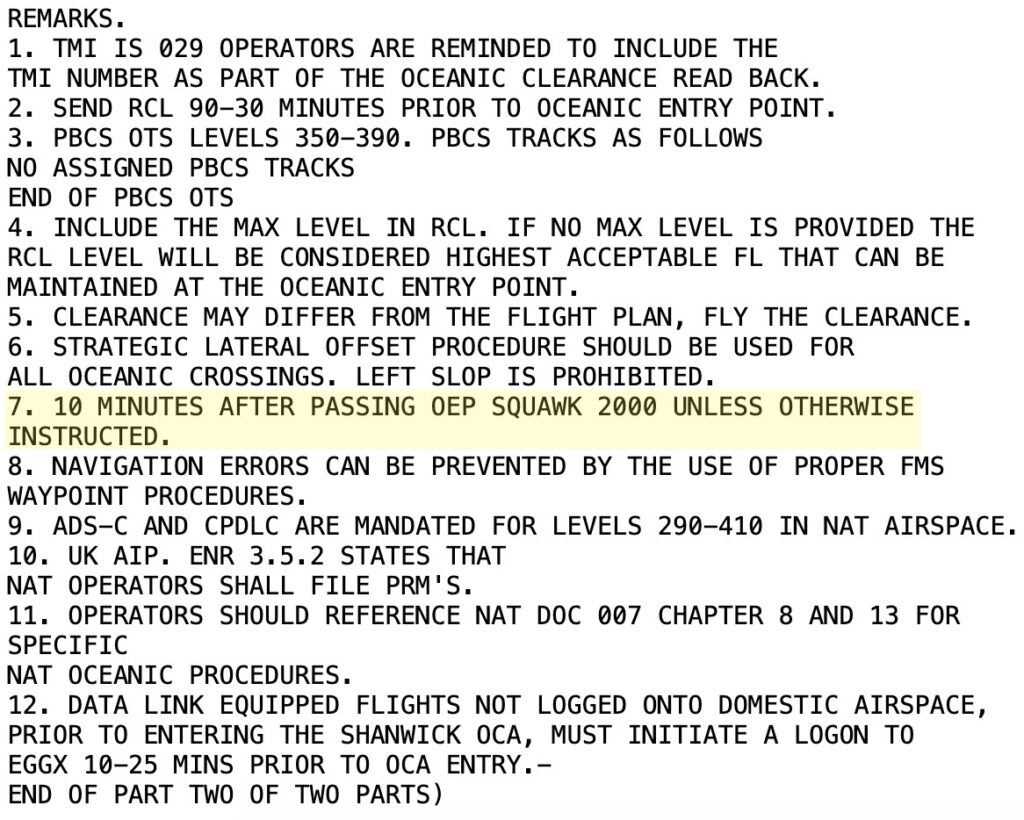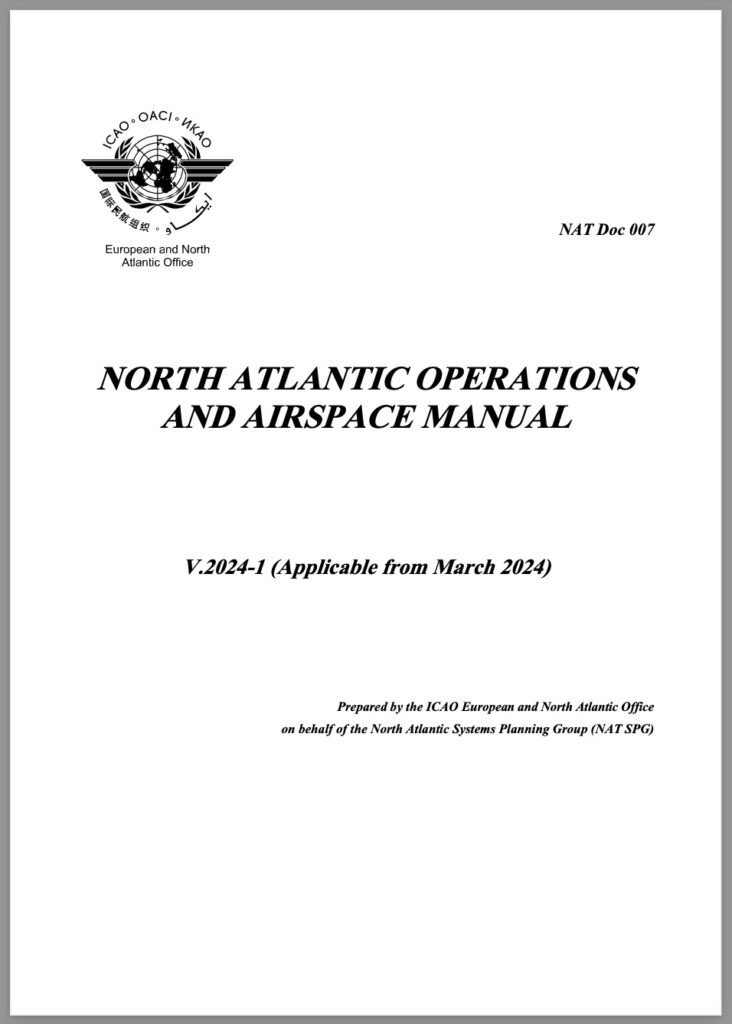Key Points
- ICAO have published a new NAT Doc 007, effective from March 2024.
- Big Change #1: There will be no more Oceanic Clearances on the NAT (now a mess).
- Big Change #2: NAT Comms Failure Procedures have been simplified.
- Big Change #3: Squawking 2000 ten minutes after OEP will be standard everywhere in the NAT.
Once (or sometimes twice) every year, ICAO update their NAT Doc 007 – the main guidance doc for ops over the North Atlantic. All the specifics about how to operate your aircraft safely through the complex airspace of the region are here!

Waiting for the new NAT Doc 007 can sometimes feel like this…
The new version for March 2024 has just been released!
Where’s the new Doc?
You can find it on the ICAO page here.
Big Change #1: No More Oceanic Clearances
The idea is that with all the fancy tools ATC now have at their disposal (CPDLC, RSP and RCP compliance, and space-based ADS-B), we have reached a point where the Oceanic Clearance is no longer required.
It sounds drastic, but think of it this way: the NAT will now just be the same as the rest of the world – you fly what is loaded in the FMS or as amended by ATC.
ICAO have also published this Bulletin for flight crews on this specific issue of the removal of Oceanic Clearances. This Bulletin has been updated as of 22nd Jan 2024. There are now different dates when Oceanic Clearances will cease to be issued in the following FIRs:
- Shanwick:
April 9MayQ4 2024December 4 - Gander:
MarchMay 3December 4 - Bodø:
MarchMay 6June 17 - Santa Maria: completed March 21
- Iceland: completed March 21
NATS (who manage Shanwick airspace) have published a video about this change, which shows exactly how it will work and what you will need to do.
Big Change #2: Simplified Comms Failure Procedures
As per Chapter 5 of the 007 Doc, from March 2024 here’s what you do:
- Comms failure before entering the NAT: assuming you don’t divert, you enter the NAT via the Oceanic Entry Point at the level and speed resulting from whatever radio comms failure (RCF) procedures you just had to do in adjacent airspace.
- Comms failure after entering the NAT: maintain the cleared route/level/speed until reaching the Oceanic Exit Point (ideally don’t change route/level/speed unless you have to), then get back to your flight planned route “in the most direct manner possible” no later than the next significant point.
- Comms failure if operating to an airport in the NAT: follow the standard PANS-ATM procedures. What are these? – head to an airport aid/fix, hold until the ETA as per the flight plan, do a normal instrument approach, land!

Big Change #3: “Last Assigned Code” Procedures Standardized
A bonus one we spotted! We don’t have to wait til April 2024 for this either – it has already happened. Essentially, squawking 2000 ten minutes after OEP is now standard in the NAT.

From the daily NAT Tracks Message.
Since the dawn of time, everywhere on the NAT, this domestic code had to be retained for 30 minutes after entering NAT airspace. But back in July 2023, the UK changed it to 10 minutes for the entire EGGX/Shanwick FIR, and since then, all the other NAT FIRs have updated their rules to say the same – so this new 10-minute rule has now become the standard across the NAT Region. One exception: if you’re in the Reykjavik CTA, don’t do it (they still have you on radar).

There’s no escape…
Phew, we survived!
More on the topic:
- More: NAT Crossing after GPS spoofing: a guide
- More: NAT Doc 007 – New Edition
- More: Don’t Climb! A Big NAT No-No
- More: Oceanic Clearance Removal mess – Version 4!
- More: NAT Clearance changes – a game! (V4)
More reading:
- Latest: Teterboro: RIP the RUUDY SIX
- Latest: 400% increase in GPS Spoofing; Workgroup established
- Latest: GPS Spoofing WorkGroup 2024
- Safe Airspace: Risk Database
- Weekly Ops Bulletin: Subscribe
- Membership plans: Why join OPSGROUP?












 Get the famous weekly
Get the famous weekly 






Hi Team,
I hope you’re all well,
I wish it was as easy as you make it look.
After Speaking to New York OCA East, the Transponder time for New York is not anticipated to change,
Therefore 30 minutes will remain the norm for KZWY. Refer to the Beacon Code section within the US AIP.
Correct me if I’m wrong but it looks to me like OWAFS is built into the new RCL process. You are allowed +/-0.2M from your requested speed unless ATC assigns a fixed Mach number. This aligns with the current RESUME NORMAL SPEED clearance. Do you know how fixed mach vs cost index will be communicated?
Unless I’m really thick between the ears, I’m not seeing the difference between RCL and Oceanic Clearances.
The piece that seems to be missing, and I read this a while back is the clearance we receive on the ground, i.e., a BED-LTN clearance will now include the entire route, vs up to the OEP as it is now.
IF this is the case, ICAO-NATSPG sure doesn’t spell that out at all!
RCL is being utilised to allow crews to easily provide the latest updates to flight plan. This allows for ATC to plan optimal routes specifically during busy periods, as the NAT is a busy place!! Why throw out what already works! Alternative is busy R/T back and forth to , now just put in details (as before) and settle into getting on with other jobs in clothe cockpit!! Route is to destination.
Good article!